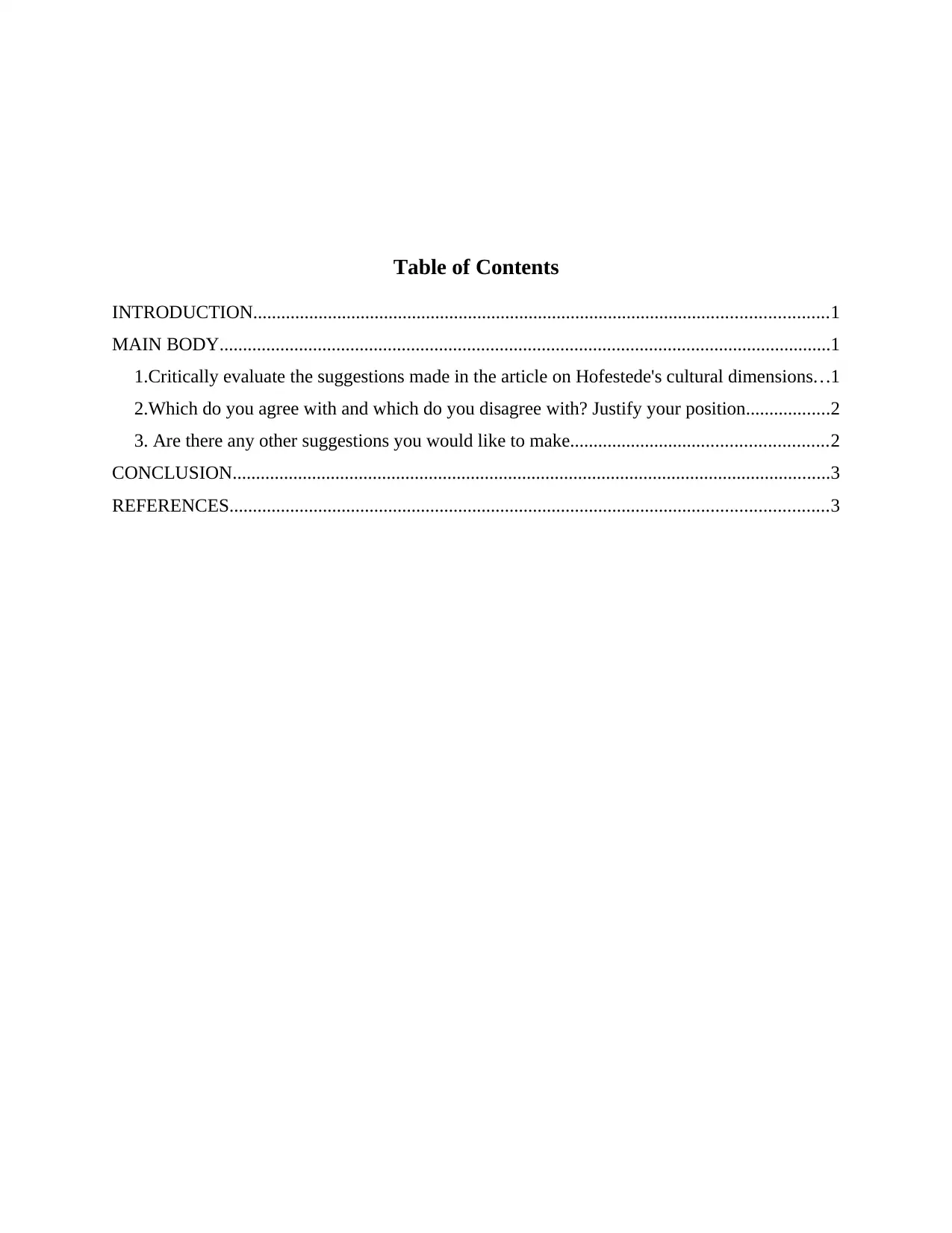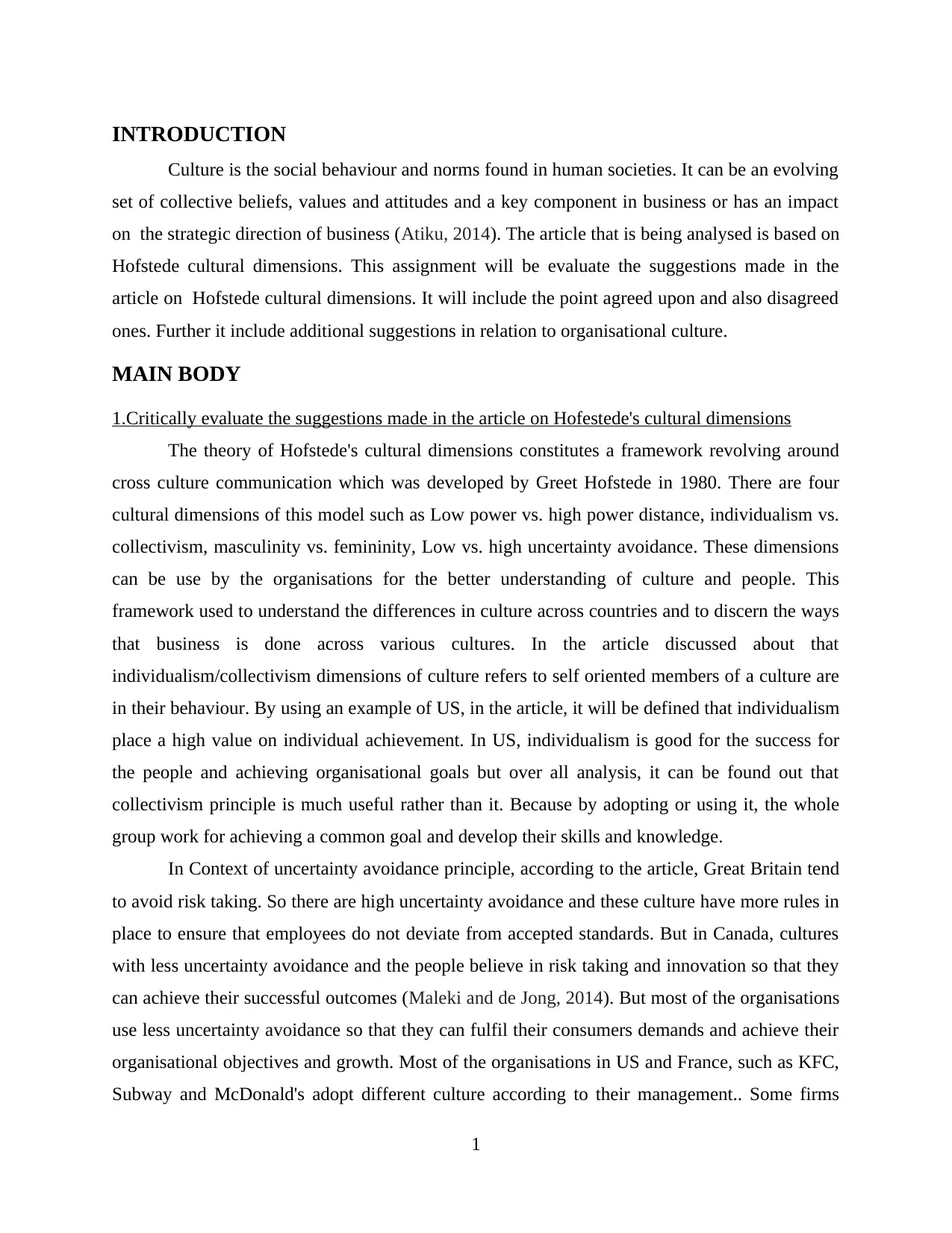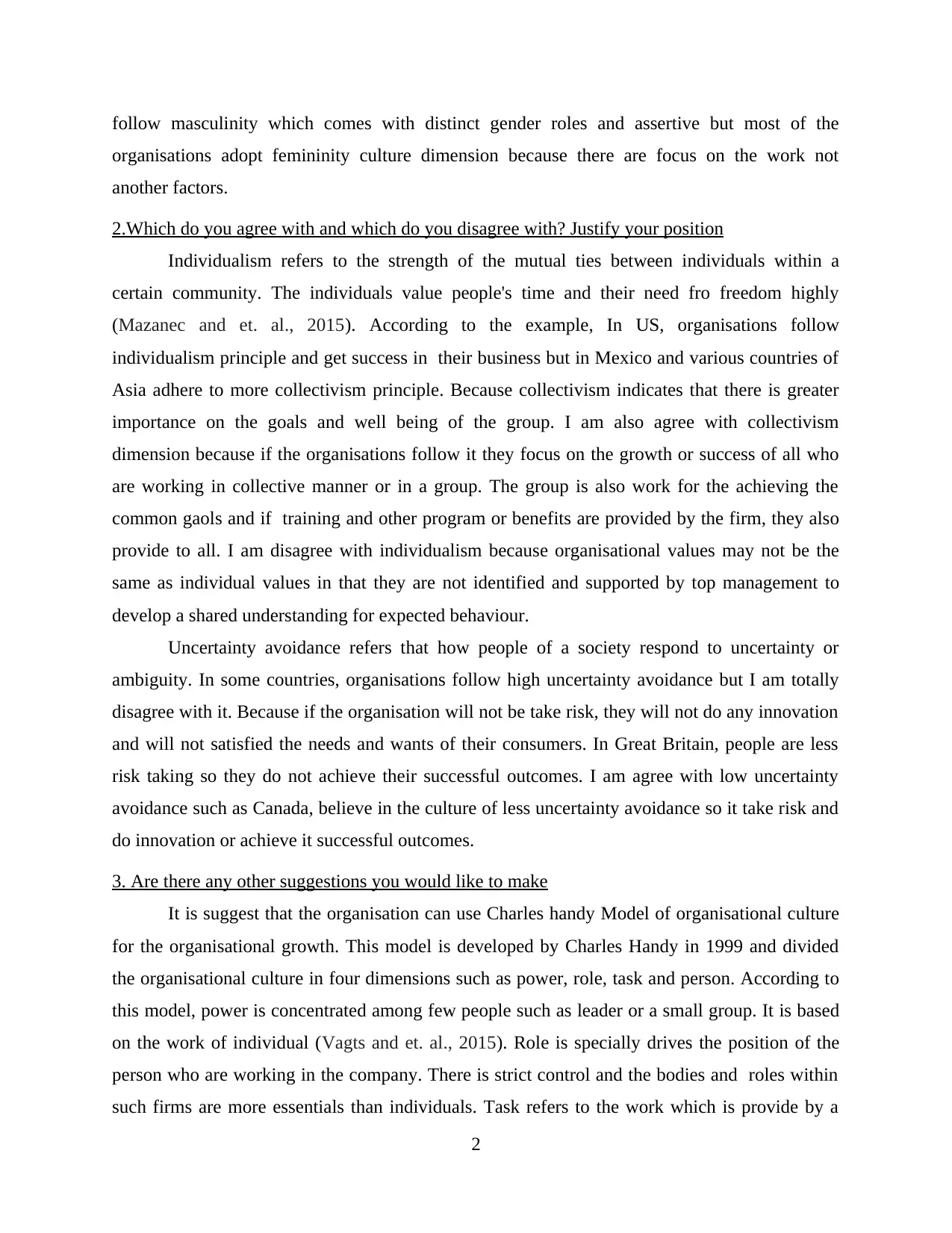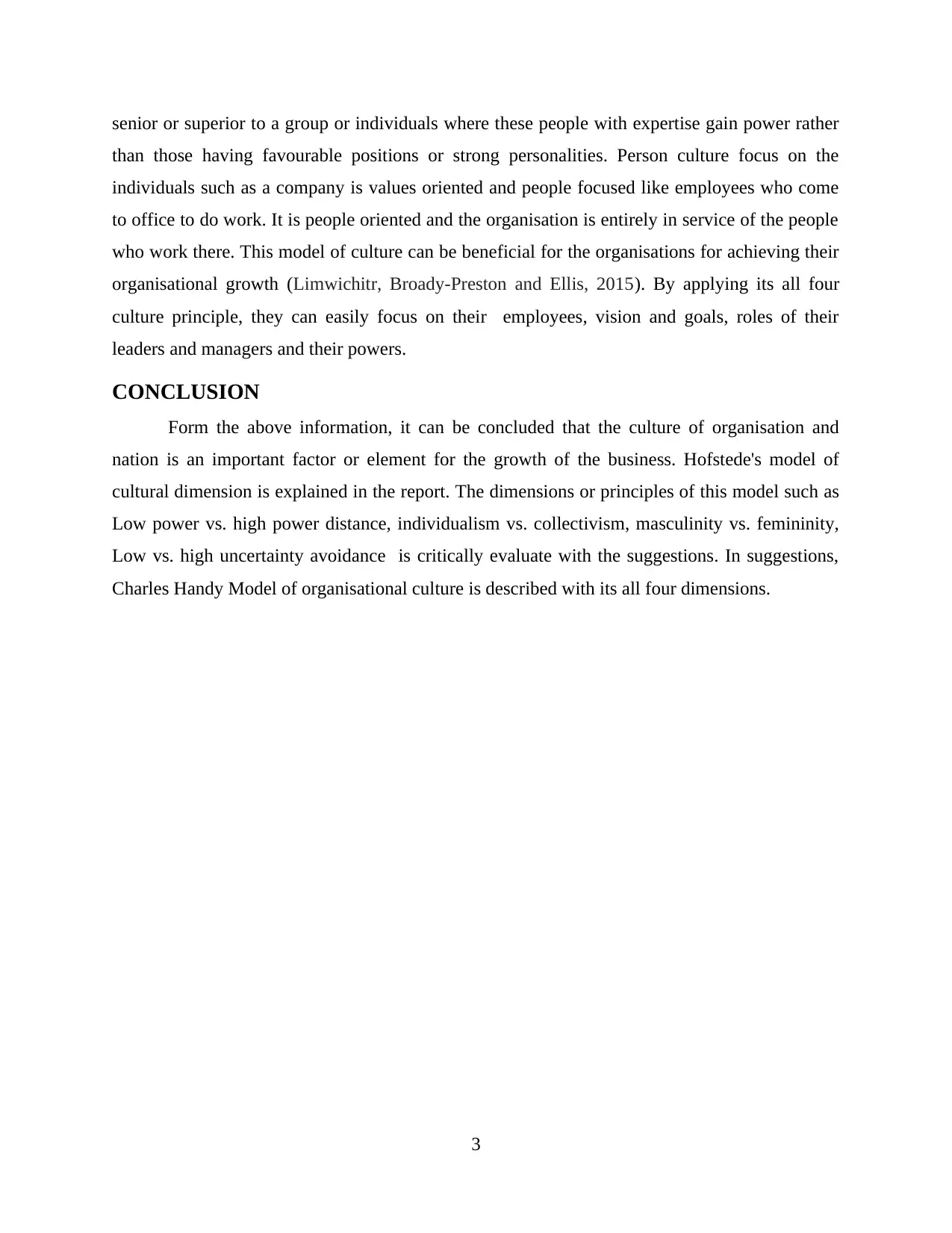Analyzing Hofstede's Cultural Dimensions: A Business Development Essay
VerifiedAdded on 2020/12/09
|6
|1369
|105
Essay
AI Summary
This essay provides a critical evaluation of Hofstede's cultural dimensions, a framework for cross-cultural communication. The essay explores the dimensions of power distance, individualism vs. collectivism, masculinity vs. femininity, and uncertainty avoidance, discussing how these concepts impact business practices and organizational culture. The author agrees with the importance of collectivism over individualism, particularly in fostering group success and achieving common goals, while disagreeing with high uncertainty avoidance. The essay further suggests the application of Charles Handy's Model of organizational culture to enhance organizational growth, focusing on power, role, task, and person-oriented cultures. The conclusion emphasizes the significance of national and organizational culture in business development, highlighting the utility of Hofstede's model and the discussed cultural dimensions.

Essay
Paraphrase This Document
Need a fresh take? Get an instant paraphrase of this document with our AI Paraphraser

Table of Contents
INTRODUCTION...........................................................................................................................1
MAIN BODY...................................................................................................................................1
1.Critically evaluate the suggestions made in the article on Hofestede's cultural dimensions...1
2.Which do you agree with and which do you disagree with? Justify your position..................2
3. Are there any other suggestions you would like to make.......................................................2
CONCLUSION................................................................................................................................3
REFERENCES................................................................................................................................3
INTRODUCTION...........................................................................................................................1
MAIN BODY...................................................................................................................................1
1.Critically evaluate the suggestions made in the article on Hofestede's cultural dimensions...1
2.Which do you agree with and which do you disagree with? Justify your position..................2
3. Are there any other suggestions you would like to make.......................................................2
CONCLUSION................................................................................................................................3
REFERENCES................................................................................................................................3

INTRODUCTION
Culture is the social behaviour and norms found in human societies. It can be an evolving
set of collective beliefs, values and attitudes and a key component in business or has an impact
on the strategic direction of business (Atiku, 2014). The article that is being analysed is based on
Hofstede cultural dimensions. This assignment will be evaluate the suggestions made in the
article on Hofstede cultural dimensions. It will include the point agreed upon and also disagreed
ones. Further it include additional suggestions in relation to organisational culture.
MAIN BODY
1.Critically evaluate the suggestions made in the article on Hofestede's cultural dimensions
The theory of Hofstede's cultural dimensions constitutes a framework revolving around
cross culture communication which was developed by Greet Hofstede in 1980. There are four
cultural dimensions of this model such as Low power vs. high power distance, individualism vs.
collectivism, masculinity vs. femininity, Low vs. high uncertainty avoidance. These dimensions
can be use by the organisations for the better understanding of culture and people. This
framework used to understand the differences in culture across countries and to discern the ways
that business is done across various cultures. In the article discussed about that
individualism/collectivism dimensions of culture refers to self oriented members of a culture are
in their behaviour. By using an example of US, in the article, it will be defined that individualism
place a high value on individual achievement. In US, individualism is good for the success for
the people and achieving organisational goals but over all analysis, it can be found out that
collectivism principle is much useful rather than it. Because by adopting or using it, the whole
group work for achieving a common goal and develop their skills and knowledge.
In Context of uncertainty avoidance principle, according to the article, Great Britain tend
to avoid risk taking. So there are high uncertainty avoidance and these culture have more rules in
place to ensure that employees do not deviate from accepted standards. But in Canada, cultures
with less uncertainty avoidance and the people believe in risk taking and innovation so that they
can achieve their successful outcomes (Maleki and de Jong, 2014). But most of the organisations
use less uncertainty avoidance so that they can fulfil their consumers demands and achieve their
organisational objectives and growth. Most of the organisations in US and France, such as KFC,
Subway and McDonald's adopt different culture according to their management.. Some firms
1
Culture is the social behaviour and norms found in human societies. It can be an evolving
set of collective beliefs, values and attitudes and a key component in business or has an impact
on the strategic direction of business (Atiku, 2014). The article that is being analysed is based on
Hofstede cultural dimensions. This assignment will be evaluate the suggestions made in the
article on Hofstede cultural dimensions. It will include the point agreed upon and also disagreed
ones. Further it include additional suggestions in relation to organisational culture.
MAIN BODY
1.Critically evaluate the suggestions made in the article on Hofestede's cultural dimensions
The theory of Hofstede's cultural dimensions constitutes a framework revolving around
cross culture communication which was developed by Greet Hofstede in 1980. There are four
cultural dimensions of this model such as Low power vs. high power distance, individualism vs.
collectivism, masculinity vs. femininity, Low vs. high uncertainty avoidance. These dimensions
can be use by the organisations for the better understanding of culture and people. This
framework used to understand the differences in culture across countries and to discern the ways
that business is done across various cultures. In the article discussed about that
individualism/collectivism dimensions of culture refers to self oriented members of a culture are
in their behaviour. By using an example of US, in the article, it will be defined that individualism
place a high value on individual achievement. In US, individualism is good for the success for
the people and achieving organisational goals but over all analysis, it can be found out that
collectivism principle is much useful rather than it. Because by adopting or using it, the whole
group work for achieving a common goal and develop their skills and knowledge.
In Context of uncertainty avoidance principle, according to the article, Great Britain tend
to avoid risk taking. So there are high uncertainty avoidance and these culture have more rules in
place to ensure that employees do not deviate from accepted standards. But in Canada, cultures
with less uncertainty avoidance and the people believe in risk taking and innovation so that they
can achieve their successful outcomes (Maleki and de Jong, 2014). But most of the organisations
use less uncertainty avoidance so that they can fulfil their consumers demands and achieve their
organisational objectives and growth. Most of the organisations in US and France, such as KFC,
Subway and McDonald's adopt different culture according to their management.. Some firms
1
⊘ This is a preview!⊘
Do you want full access?
Subscribe today to unlock all pages.

Trusted by 1+ million students worldwide

follow masculinity which comes with distinct gender roles and assertive but most of the
organisations adopt femininity culture dimension because there are focus on the work not
another factors.
2.Which do you agree with and which do you disagree with? Justify your position
Individualism refers to the strength of the mutual ties between individuals within a
certain community. The individuals value people's time and their need fro freedom highly
(Mazanec and et. al., 2015). According to the example, In US, organisations follow
individualism principle and get success in their business but in Mexico and various countries of
Asia adhere to more collectivism principle. Because collectivism indicates that there is greater
importance on the goals and well being of the group. I am also agree with collectivism
dimension because if the organisations follow it they focus on the growth or success of all who
are working in collective manner or in a group. The group is also work for the achieving the
common gaols and if training and other program or benefits are provided by the firm, they also
provide to all. I am disagree with individualism because organisational values may not be the
same as individual values in that they are not identified and supported by top management to
develop a shared understanding for expected behaviour.
Uncertainty avoidance refers that how people of a society respond to uncertainty or
ambiguity. In some countries, organisations follow high uncertainty avoidance but I am totally
disagree with it. Because if the organisation will not be take risk, they will not do any innovation
and will not satisfied the needs and wants of their consumers. In Great Britain, people are less
risk taking so they do not achieve their successful outcomes. I am agree with low uncertainty
avoidance such as Canada, believe in the culture of less uncertainty avoidance so it take risk and
do innovation or achieve it successful outcomes.
3. Are there any other suggestions you would like to make
It is suggest that the organisation can use Charles handy Model of organisational culture
for the organisational growth. This model is developed by Charles Handy in 1999 and divided
the organisational culture in four dimensions such as power, role, task and person. According to
this model, power is concentrated among few people such as leader or a small group. It is based
on the work of individual (Vagts and et. al., 2015). Role is specially drives the position of the
person who are working in the company. There is strict control and the bodies and roles within
such firms are more essentials than individuals. Task refers to the work which is provide by a
2
organisations adopt femininity culture dimension because there are focus on the work not
another factors.
2.Which do you agree with and which do you disagree with? Justify your position
Individualism refers to the strength of the mutual ties between individuals within a
certain community. The individuals value people's time and their need fro freedom highly
(Mazanec and et. al., 2015). According to the example, In US, organisations follow
individualism principle and get success in their business but in Mexico and various countries of
Asia adhere to more collectivism principle. Because collectivism indicates that there is greater
importance on the goals and well being of the group. I am also agree with collectivism
dimension because if the organisations follow it they focus on the growth or success of all who
are working in collective manner or in a group. The group is also work for the achieving the
common gaols and if training and other program or benefits are provided by the firm, they also
provide to all. I am disagree with individualism because organisational values may not be the
same as individual values in that they are not identified and supported by top management to
develop a shared understanding for expected behaviour.
Uncertainty avoidance refers that how people of a society respond to uncertainty or
ambiguity. In some countries, organisations follow high uncertainty avoidance but I am totally
disagree with it. Because if the organisation will not be take risk, they will not do any innovation
and will not satisfied the needs and wants of their consumers. In Great Britain, people are less
risk taking so they do not achieve their successful outcomes. I am agree with low uncertainty
avoidance such as Canada, believe in the culture of less uncertainty avoidance so it take risk and
do innovation or achieve it successful outcomes.
3. Are there any other suggestions you would like to make
It is suggest that the organisation can use Charles handy Model of organisational culture
for the organisational growth. This model is developed by Charles Handy in 1999 and divided
the organisational culture in four dimensions such as power, role, task and person. According to
this model, power is concentrated among few people such as leader or a small group. It is based
on the work of individual (Vagts and et. al., 2015). Role is specially drives the position of the
person who are working in the company. There is strict control and the bodies and roles within
such firms are more essentials than individuals. Task refers to the work which is provide by a
2
Paraphrase This Document
Need a fresh take? Get an instant paraphrase of this document with our AI Paraphraser

senior or superior to a group or individuals where these people with expertise gain power rather
than those having favourable positions or strong personalities. Person culture focus on the
individuals such as a company is values oriented and people focused like employees who come
to office to do work. It is people oriented and the organisation is entirely in service of the people
who work there. This model of culture can be beneficial for the organisations for achieving their
organisational growth (Limwichitr, Broady-Preston and Ellis, 2015). By applying its all four
culture principle, they can easily focus on their employees, vision and goals, roles of their
leaders and managers and their powers.
CONCLUSION
Form the above information, it can be concluded that the culture of organisation and
nation is an important factor or element for the growth of the business. Hofstede's model of
cultural dimension is explained in the report. The dimensions or principles of this model such as
Low power vs. high power distance, individualism vs. collectivism, masculinity vs. femininity,
Low vs. high uncertainty avoidance is critically evaluate with the suggestions. In suggestions,
Charles Handy Model of organisational culture is described with its all four dimensions.
3
than those having favourable positions or strong personalities. Person culture focus on the
individuals such as a company is values oriented and people focused like employees who come
to office to do work. It is people oriented and the organisation is entirely in service of the people
who work there. This model of culture can be beneficial for the organisations for achieving their
organisational growth (Limwichitr, Broady-Preston and Ellis, 2015). By applying its all four
culture principle, they can easily focus on their employees, vision and goals, roles of their
leaders and managers and their powers.
CONCLUSION
Form the above information, it can be concluded that the culture of organisation and
nation is an important factor or element for the growth of the business. Hofstede's model of
cultural dimension is explained in the report. The dimensions or principles of this model such as
Low power vs. high power distance, individualism vs. collectivism, masculinity vs. femininity,
Low vs. high uncertainty avoidance is critically evaluate with the suggestions. In suggestions,
Charles Handy Model of organisational culture is described with its all four dimensions.
3

REFERENCES
Books & Journals
Atiku, S. O., 2014. The relationship between organisational culture and performance: a case of
the banking sector in Nigeria (Doctoral dissertation).
Maleki, A. and de Jong, M., 2014. A proposal for clustering the dimensions of national culture.
Cross-Cultural Research. 48(2). pp.107-143.
Mazanec, J. A. and et. al., 2015. Homogeneity versus heterogeneity of cultural values: An item-
response theoretical approach applying Hofstede's cultural dimensions in a single
nation. Tourism Management. 48. pp.299-304.
Vagts, D. F. and et. al., 2015. Transnational business problems. West Academic.
Limwichitr, S., Broady-Preston, J. and Ellis, D., 2015. A discussion of problems in
implementing organisational cultural change: Developing a learning organisation in
university libraries. Library Review. 64(6/7). pp.480-488.
4
Books & Journals
Atiku, S. O., 2014. The relationship between organisational culture and performance: a case of
the banking sector in Nigeria (Doctoral dissertation).
Maleki, A. and de Jong, M., 2014. A proposal for clustering the dimensions of national culture.
Cross-Cultural Research. 48(2). pp.107-143.
Mazanec, J. A. and et. al., 2015. Homogeneity versus heterogeneity of cultural values: An item-
response theoretical approach applying Hofstede's cultural dimensions in a single
nation. Tourism Management. 48. pp.299-304.
Vagts, D. F. and et. al., 2015. Transnational business problems. West Academic.
Limwichitr, S., Broady-Preston, J. and Ellis, D., 2015. A discussion of problems in
implementing organisational cultural change: Developing a learning organisation in
university libraries. Library Review. 64(6/7). pp.480-488.
4
⊘ This is a preview!⊘
Do you want full access?
Subscribe today to unlock all pages.

Trusted by 1+ million students worldwide
1 out of 6
Related Documents
Your All-in-One AI-Powered Toolkit for Academic Success.
+13062052269
info@desklib.com
Available 24*7 on WhatsApp / Email
![[object Object]](/_next/static/media/star-bottom.7253800d.svg)
Unlock your academic potential
Copyright © 2020–2026 A2Z Services. All Rights Reserved. Developed and managed by ZUCOL.





